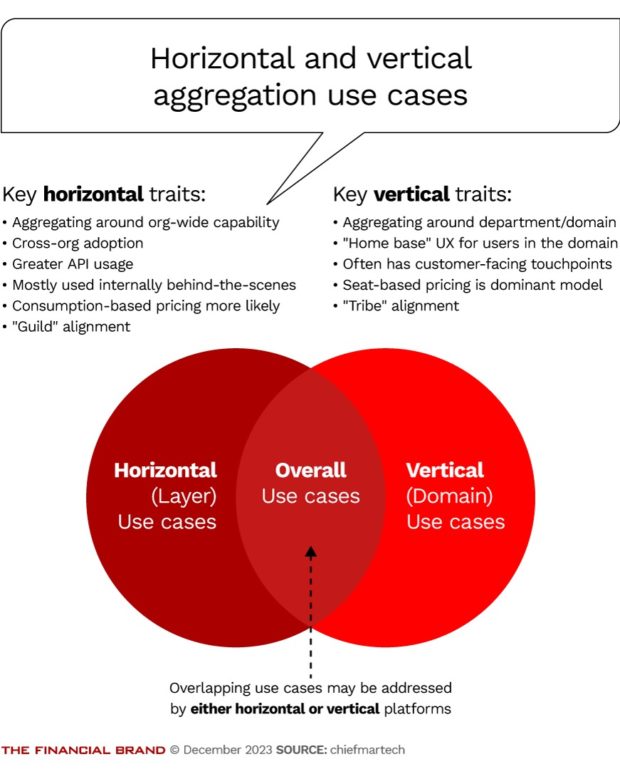The report: Martech for 2024 [December 2023]
Source: Chiefmarctech blog, MartechTribe
Why we picked it: Martech for 2024 is published by MartechTribe, a martech research and benchmarking company, and Scott Brinker’s marketing technology blog chiefmartec, which is best known for its annual and definitive (if almost indecipherable) martech vendor landscape.
We hoped that, from their authoritative vantage point, they could help deliver some clarity on the confused and confusing martech options available.
Executive Summary
While the economic environment has many marketing departments under pressure to cut costs and demonstrate value, the number of shiny new marketing tools is expanding at a staggering rate. As a result, marketers must get more selective and focus on delivering value as they assemble and refine their martech stacks.
Martech for 2024 is nearly 100 pages long, and offers data and analysis of the martech market, including trends in the vendor landscape. It also takes a deeper dive into trends in how martech can be architected and managed. In the last part of the report, five martech C-suite leaders offer their perspectives on AI, layers, responsible marketing and other issues in 2024.
Key Takeaways
• There are now more than 13,000 solutions on the market, and the arrival of new products only accelerated in late 2023, thanks to AI.
Marketers are under pressure from their respective c-suites to consolidate. One Gartner report claimed that, on average, companies were only “utilizing” 33% of their martech capabilities, a decline of almost 10% just since 2022.
• Many marketers are trying to manage their growing stacks to deliver greater utilization, consolidation and aggregation.
What we liked: This report has a lot of great information about trends in martech, offering readers a deep look into the space.
What we didn’t: This report may be more geared towards IT, tech-oriented marketers and software buyers than to marketing directors. Marketers must dig and work hard to find actionable advice and insights.
Things that made us go “Hmm”: In the highly volatile martech space, picking the wrong vendor or technology can be disruptive, or even deadly, to any marketer’s best laid plans. From May 2022 to May 2023, the authors report, “We removed 639 companies from our landscape that were consolidated away — a non-trivial 7% churn rate.” Be especially wary of vendors in the 12,000-strong “long tail” – typically, any company with less than $100 million in revenue.

Navigating Credit Card Issuing in an Uncertain Economic Environment
Build a modern credit card strategy that balances profitability and risk, adopts the latest technology and delivers the customization that cardholders demand.
Read More about Navigating Credit Card Issuing in an Uncertain Economic Environment

The Power of Localized Marketing in Financial Services
Learn how to enhance your brand’s local visibility, generate more leads, and attract more customers, all while adhering to industry regulations and compliance.
Read More about The Power of Localized Marketing in Financial Services
Key Trends to Watch
Martech is growing faster than ever: The authors catalogue more than 13,000 solutions, a net increase of more than 18% just over the past six months. Much of this growth has been driven by generative AI, primarily applications focusing on content marketing, sales enablement and business intelligence.
Most new generative AI tools appeared in categories that are already densely populated with product:
- Content marketing,
- Sales enablement, automation and intelligence,
- Business/customer intelligence and data science.
Tech stacks are getting larger and more complex: Many companies have massive stacks, and data indicates the number of subscriptions continues to grow. The average company with 1 to 500 employees has 172 SaaS subscriptions, while those with more than 10,000 employees have well over 650 subscriptions.
Sharpening focus on cutting costs and demonstrating value: Three-quarters of chief marketing officers say their organization faces growing demands to cut marketing technology spending to deliver better ROI. Departments are not just cutting existing software, but reigning in new purchases, as software renewals and new contracts fell notably between 2022 and 2023.
The challenge of balancing consolidation with innovation: Even while marketers cut costs, they are also being pulled in the other direction by innovation. Marketers must walk a fine line between embracing too many tools too quickly and overlooking promising or innovative opportunities.
“While the forces of consolidation — or, really, rationalization — should serve to reduce the number of products in martech stacks, and therefore the number of vendors in the market, there’s a countervailing force that is pushing hard in the opposite direction: innovation.”
The devil in the details: Marketers must act with discipline and lean management to simplify their stack. However, the value of tools cannot always be measured by frequency or the depth of their usage. In fact, some redundancy and overlap may support important use cases.
Consolidation and utilization: While marketers are optimistic about 2024, budgets will likely remain tight. As a result, marketers need to focus on customers and business use cases and the features that will drive value. Yet, removing tools isn’t the answer. Sometimes, it’s about replacing a current app with a better one or making investments in internal tailing to better use the products they already have.
All things being equal, the simplest stack is best.
Aggregate vertically and horizontally: Companies must engage in both horizontal and vertical aggregation to make the most of what they already have.
For instance, consolidation simplifies a martech stack, and aggregation makes a large set of tools easier to operate. Software platforms that aggregate data and services across the tech stack aim to make diverse and distributed data and services easier to consume and in a more consistent and cohesive fashion.
Read more:
- Why Bank Martech Platforms Need a First-Party Data Identity Foundation
- One Key Martech Tool Financial Marketers Should Use to Leverage Data
Perspectives for 2024
The final section of the report features insight from five martech C-suite leaders.
Customer journey layers: Christopher Sell, the co-founder and chief executive of GrowthLoop, argues that applying generative AI to the customer journey layer will enable marketers to continually improve performance in coming years.
His take is that generative AI will become better at making suggestions for unique journeys and paths. However, humans will still be critical in every step of the way. AI will not replace marketers; the real value will be in enabling them to test ideas faster and more effectively without being beholden to teams and technologies at each step.
Customer data infrastructure: Michael Katz, the co-founder and chief executive of mParticle, is focused on how the rise of the cloud data warehouse empowers knowledge workers with access to first-party data. Faced with larger volumes of data, traditional analytics tools are falling short. Marketers now need advanced machine learning to help uncover intricate patterns that are beyond the scope of conventional analytical tools.
Bottlenecks to personalization: George Khachatryan, the co-founder and chief executive of OfferFit , says marketers still face three bottlenecks in the path to personalization: data integration, content creation, and experimentation. Fortunately, AI will help solve many of these issues in the coming years.

Responsible marketing: Jonathan Moran, head of martech solutions marketing for SAS, and Michael Obermaier, SAS’s senior manager of the martech advisory practice in Germany, observe that while most consumers want businesses to be transparent about their business practices, only a quarter of CIOs and CTOs report being strongly concerned about the ethical or responsible use of data and technology.
Responsible marketing has three components. One is the responsible use of customer and marketing data that balances personalization and privacy. Another is the imperative to use technology responsibly, promoting accuracy, safety, and honestly. Finally, organizations need to deploy organizational resources more wisely, with a focus on marketing as a revenue generator rather than a cost center.
Operationalizing first-party data: Alex Dean, the co-founder and chief executive of Snowplow argues that, as third-party data becomes less accessible, marketers are moving more to first-party data. The big trend in the past few years has been the rise of the data warehouse, where brands can capture all their data in their own ecosystem. New tools are now adding a front-end for marketers on top of the data, eliminating data silos and unifying the customer view.
Craig Guillot is a longtime contributor to The Financial Brand who specializes in technology. He often writes about IoT, cybersecurity and SaaS. His work has appeared in The Wall Street Journal, Entrepreneur and elsewhere.








